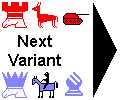Indian Chess
Keys "s"=save "l"=load "b"=back once
Here are some regional variants which were popular in India during British occupation.
I used an 8-move mobilization phase during which no piece can be moved to the opponent's side of the board, or moved twice.
The king starts to the right of the queen.
If the king has not been in check, he can make one knight's move, but not to capture. I thought check during the mobilization phase, except when it is over, doesn't count for this. Knight's and Bishop's pawns never make the initial two-square advance, and other pawns can only do this if a piece of the original kind is present on the first rank. I thought this would be whether or not it had previously moved.
Pawns promote to the piece that belongs to the file; queen on the king file. I have implemented the rule requiring (if possible) a newly-promoted knight on a square not under attack to make a free move.
Bare king is a draw, and if there are fewer than 5 units total on the board it is a draw. Mating with a pawn move is a double win. Stalemate is illegal; it will get your move retracted.
There is no castling.
These are simple illustrations rather than strong opponents.
Bug Reports -- Thank you! Keep them coming!
Written by Ed Friedlander
WWW Page Added: Sunday, December 30, 2001




